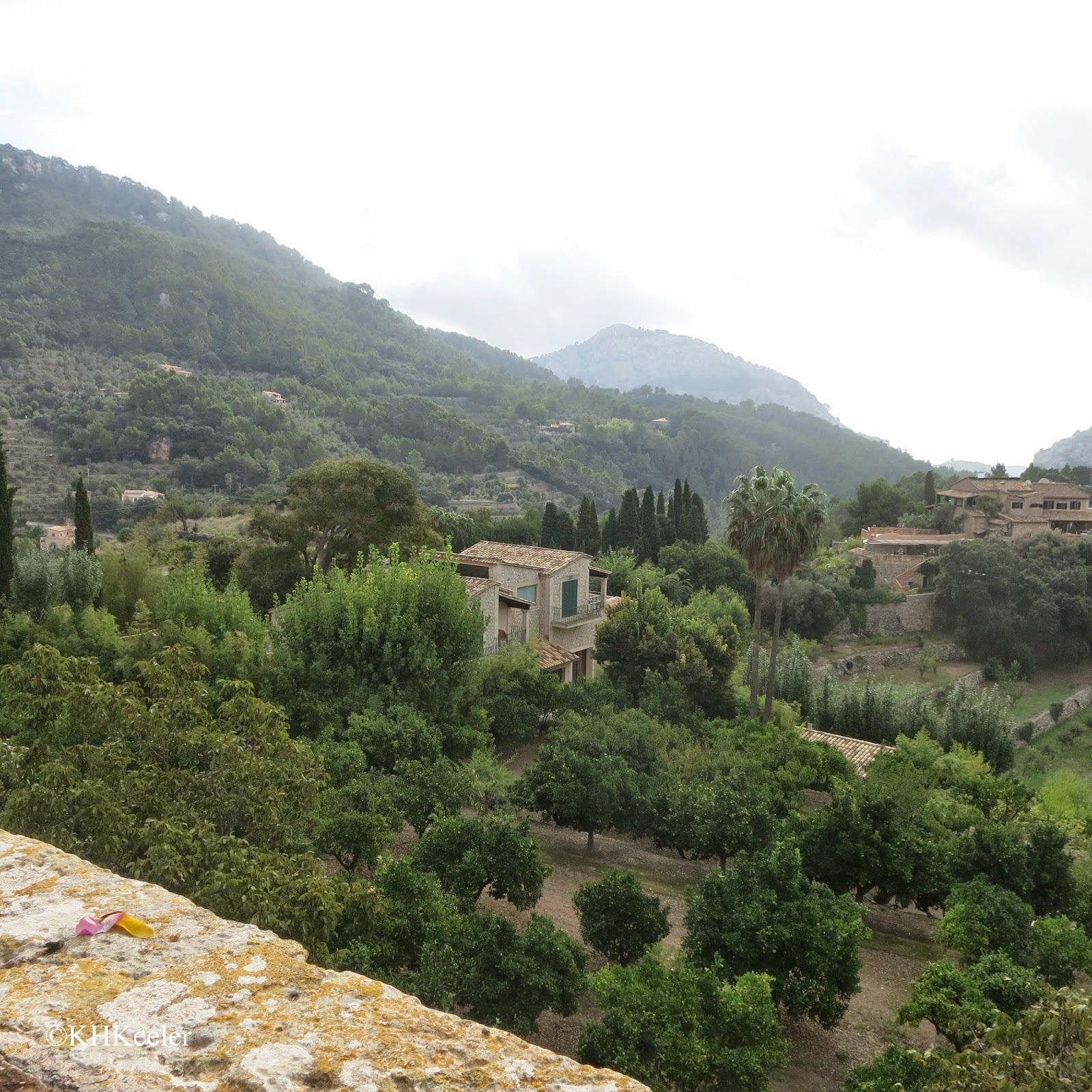 |
| Hills of Mallorca |
A rambling old building, of which I have no exterior photograph (so see link), it was begun as a royal residence, then, between 1399 and 1835, served as a Carthusian monastery. After that it was a private guest house and today it is a museum.
The museum had displays about many different periods in its history. A former monastery is a good venue for that: lots of different rooms suitable for different topics.
 |
| monastery pharmacy |
 |
| medicinal herbs, monastery pharmacy, Mallorca |
At the top of the photograph you can see semillas de perifollo. These are chervil, Anthriscus cerefolium, seeds. Chervil is an annual related to dill (dill family, Apiaceae) which, although coming from Eurasia, has been grown in Europe since classical Greece and undoubtedly grows on Mallorca. None of my sources use the seeds medicinally, but rather the leaves, to cleanse the stomach and heal bruises (see for example Culpeper's herbal).
Below the semillas de perifollo are trociscos de rhubarb. Those are small balls of rhubarb. Rhubarb (Rheum spp.) came from Asia as a medicinal in the late Middle Ages and was not used as food by Europeans until perhaps 1800. The root provided the medicine and was used as a purgative.
In the lower left are agallas de Aleppo, galls of Aleppo, that is, oak galls from the Aleppo oak, Quercus infectoria. Although the native oaks of Mallorca undoubtedly produced galls, these would have been imported from the eastern end of the Mediterranean. Medically they were used as an astringent.
Next to the galls are nuez vomica, seeds of Strychnos nux-vomica, the strychnine tree, also called nux vomica (plant family Loganiaceae). Nux vomica are way too toxic to be used medicinally today, but were widely used historically (see description of in Mrs. Grieve's herbal, also, enjoy the comments at The Poison Garden). The strichnine tree is native to Asia and does not seem to have been grown in Europe but the seeds travel easily and store well so they have been used there for millennia.
Trociscos de Gordon are Gordon's troches (a troche is a tablet or lozenge) which combined powdered seeds of white poppies, mallows, cotton, purslain, quinces and other plants. A recipe from 1772 is online at London College of Physicians which states they were used for "distempers" of the kidneys and urinary passages.
Raiz de galanga is the root of galangal, Alpinia officinarum. Galangal is a relative of ginger (ginger family Zingiberaceae) and its root was widely used as a spice in medieval Europe and as a medicinal, for stomach problems and sea sickness. See Mrs. Grieve for more: link.
(The internet is such a wonderful resource! The first language on those labels is Catalan, the language of Mallorca, the second Latin. I do not have a Catalan dictionary, and my Latin dictionaries don't have many medical or botanical terms, but with the help of the internet, I could work out the plant names.)
Thus the museum pharmacy featured an array of plants used as medicines, some clearly imported, some probably locally gathered, most of them just dried plant parts but one a very complex compound. The herbal medicines may have been assembled recently for the display but elsewhere in the museum are many items left by the Carthusians, so it is likely these medicines were at the monastery in 1835 when the government confiscated the property and expelled the monks. I rarely think of it, but the pharmacy reminded me how are fortunate we are for the progress in medicine of the last 200 years.
Later in the tour, we walked back through the monks' cells, behind the public areas. There we were shown the abbot's cell. On his top shelf were additional jars of medicines. The guide explained that the expensive and/or dangerous drugs were kept by the abbot and small amounts given out for particular uses, with the abbot keeping careful records to avoid abuse. That is a procedure that we carry out today but that I hadn't thought of as going back hundreds of years.
 |
| Dangerous herbs on top shelf, below a display of artifacts. |
Each monk's cell that we saw opened up to an enclosed garden.
Each garden was different. Some were full of flowers, another had few flowers but many aromatic shrubs and small trees. It was easy to imagine the little gardens expressing the personalities of the different monks, even though we are 180 years later and the plants must currently represent the preferences of the people who maintain the buildings.
 |
| monk's private garden |
 |
| a second monk's private garden |
 |
| View from private garden outside Carthusian monk's cell. |
 |
| View private garden outside Carthusian monk's cell. |
There was much more to see, but the view of monastery life caught my imagination.
References
Culpeper, N. 1814. Culpeper's Complete Herbal and the English Physician (originally 1652-1653, much reprinted) http://www.complete-herbal.com/index.htm
Grieve, Mrs. M. 1932. A Modern Herbal. online at http://botanical.com (She did an excellent job of compiling information on medicinal plants).
Quincy, J. 1772. The Dispensary of the Royal College of Physicians in London 2nd edition. online
van Wyck, B-E. 2005. Food Plants of the World. Timber Press, Portland, OR.
Kathy Keeler
More at awanderingbotanist.com
Join me on Facebook: https://www.facebook.com/AWanderingBotanist


No comments:
Post a Comment